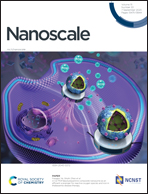Catalytic nickel silicide as an alternative to noble metals in metal-assisted chemical etching of silicon†
Abstract
Metal-assisted chemical etching (MACE) has received much attention from researchers because it can be used to fabricate plasma-free anisotropic etching profiles for semiconductors. However, the etching mechanism of MACE is based on the catalytic reaction of noble metals, which restricts its use in complementary metal oxide semiconductor (CMOS) processes. To obtain process compatibility, we developed catalytic Ni after alloying it with Si as a substitute for noble metals in the MACE of Si substrates. Nickel silicide is a material commonly used as a contact electrode in CMOS processes. When NiSi was used as the catalyst, the anisotropic etching of Si with a smooth surface was successfully demonstrated. Silicidation increased the standard reduction potential of the Ni alloy and enhanced the electrochemical stability in the MACE of Si. In contrast, when pure Ni was used as the catalyst, a rough-etched surface was fabricated because of the low standard reduction potential. Based on the experimental results, the factors affecting the MACE of Si were systematically analyzed to optimize the catalytic NiSi properties. The implementation of the NiSi alloy potentially eliminates the use of noble metals in MACE and allows the technology to be adopted in contemporary CMOS processes.



 Please wait while we load your content...
Please wait while we load your content...